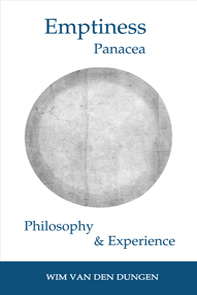|
Book I
of the Manual on Buddhist Practices
is subdivided in Preliminary, Foundational, Accumulative &
Preparative Practices. These are
based on the Sûtras.
-
Preliminary : elementary practices,
covering body, breath & mind ;
-
Foundational : building
the foundation to be able to quickly generate merit ;
-
Accumulative : practices to
ongoingly increase the accumulation of merit ;
-
Preparative :
realizing the conceptual mind approximating ultimate reality.
In
Book II,
practices based on the Tantras are discussed. These are the so-called
"Finative Practices", activities actually realizing
liberation &
awakening
on the basis of a non-conceptual mind of dual-union, directly prehending
emptiness.
Each set of practices enduces a specific degree of calmness :
* Preliminary Practices : calmness ;
* Foundational Practices : deep calmness ;
* Accumulative Practices : deeper calmness ;
* Preparative Practices : insightful calmness ;
* Finative Practices : profound calmness.
These practice levels are consistent with the Five Paths of Kamalashila (ca.
700 - 750 CE) :
-
Path of Accumulation
("Gate")
: entered upon the spontaneous arising of the mind of enlightenment for all
sentient beings (Bodhicitta), becoming a Bodhisattva who attained
meditative equipoise (Calm Abiding), the practice of the Six Perfections causes the two baskets
(of
merit and
wisdom)
to be filled. By improving their
method and
wisdom, Bodhisattvas train in generating
virtuous minds, the Four Immeasurables and the Six Perfections.
Understanding of emptiness is enhanced by relying principally on the
wisdoms arising from listening and reflecting.
Self-cherishing is
eliminated ;
-
Path of Preparation
("Gate")
: the primary focus here is attaining the best
understanding of emptiness ("prajñâ"),
and this by relying on the wisdom from Emptiness Meditation (Insight
Meditation).
Calm Abiding with emptiness as object of placement is practiced. "Superior
seeing" is attained (calmness sharpening analysis and analysis deepening
calmness). On the basis of this "superior seeing",
"special insight" realizes an exceedingly abstract conceptual insight into (and generic
idea of) self-emptiness, the fundamental nature of all phenomena ; absence
of inherent existence. Because it is conceptual and so not yet existence
as it is ("yathâbhûtam", in accordance to what is), this idea rises
immediately after the appearance, not yet simultaneously. But once achieved, this
pinnacle of conceptual understanding or common wisdom
is irreversible. This Path of Preparation is a stepping-stone to directly perceive
("see" or prehend)
emptiness (on the Path of Seeing), for when the conceptual mind is truly convinced of the
formal (logical), functional & critical rational
grounds for the absence of inherent existence or substantiality
(self-powered own-form or "self"), it has the power to identify
the illusions of conventional reality, thereby generating the conceptual antidote
for acquired (intellectual) self-grasping. At this point, conceptual
"avidyâ", ignorance of ultimate truth because of acquired, intellectual
delusion is over (but non-conceptual ignorance caused by innate delusions
not) ;
The Path of Preparation has four stages, called "Heat", "Peak", "Patience" &
"Supreme
Dharma" :
1. Heat : the beginning of a very powerful enthusiasm to arrive at
the best possible understanding of
wisdom ("prajñâ"). This "fire" of
conceptual wisdom is the approximative
precursor of the unconditioned "gnosis" present on the
Path of Seeing, this prehension or intuition of emptiness ("jñâna"). In meditative equipoise, a clear
conceptual understanding of suchness is realized ;
2. Peak : the culmination of this strong love of
common wisdom is an intense conceptual mind grasping at the idea of emptiness, as if this mind mixes with
emptiness itself, which is not the case.
The virtuous roots cultivated will no longer be lost or cease. Conceptual
understanding of suchness exponentially increases ;
3. Patience : a special attitude towards Dharma in general and
the idea of emptiness in particular is the case. Gross conceptual
reification
is gone, but subtle conceptual reifications remain, hindering a complete
mixing of the mind with emptiness. Nevertheless, a refined experience of
emptiness is the case. One is no longer reborn in the lower
realms of "samsâra" ;
4. Supreme Dharma : here mind and emptiness are
nearly mixed for the emptiness of the idea of emptiness is understood,
meaning all acquired self-grasping has nearly completely ceased (all but
the idea of emptiness itself). The emptiness of objects still rises
after their appearances. This is the highest existence of all ordinary Bodhisattva.
All their experiences are supreme Dharma Paths of Preparation, and all worldly attributes
necessary for the path are attained. Object & subject are
relational, no longer
consciously perceived as separate.
Acquired self-grasping is totally
eliminated ;
-
Path of Seeing
("PÂRAGATE")
: entered upon (a) an approximation of seeing emptiness
through conceptual understanding and (b) the cessation of conceptualization hand in hand with
being present in the actual moment, a direct experience of emptiness
during meditative equipoise happens.
-
Path of Meditation
("PÂRASAMGATE")
: thanks to deeper Insight Meditations on the remaining perfections (ethics,
patience, joyous effort, concentration, wisdom), the direct experience of
the First Stage is deepened, stabilized
& refined by way of the remaining levels. To eliminate the subtle & very subtle delusions (obscurations
caused by innate self-grasping and obscurations hindering omniscience), the
Bodhisattva has to train further (stages two to seven : thoroughly go, and
stages eight to ten : bodhi).
The experience of emptiness of
the Hînayâna Arhat is identified with end of the Sixth Stage. The Seventh
Stage offers the Bodhisattva a mind entering into absorption on emptiness
and rising again in a finger snap. Only the obstructions to
omniscience remain (to be dealt with on the Eight to Tenth Stage). The
Eight Stage Great Bodhisattva or Mahâsattva Bodhisattva equals Dhyâni
Bodhisattvas, the emanations from enlightened beings and knows when his or
her awakening will happen. In the Ninth, the wisdom of the Bodhisattva is
complete. The Tenth Stage, the Bodhisattva actually enters Buddhahood.
Innate self-grasping is totally
eliminated, omniscience a fact ;
-
Path of No More
Learning ("BODHI") :
this is
the state of Buddhahood, the nondual simultaneous experience (prehension) of
conventional & ultimate truth, of "samsâra"
& "nirvâna",
of
compassion &
wisdom ; luminous emptiness.
There are two types of Analytical Meditations : (1)
discursive meditations on a variety of core themes of the Buddhadharma
("lamrim") and (2) Insight Meditations or Emptiness Meditations.
The present guided meditations are Insight Meditations.
The First Set of Insight Meditations are guided Analytical
Meditations belonging to the stage of the Preparative Practices. The Path
of Preparation ends with the conceptual (approximative) realization of
self-emptiness (on the basis of a non-affirmative negation of inherent
existence).
The Second Set of Insight Meditations are guided Analytical Meditations
belonging to the stage of the Finative Practices.
From the
First Bhûmi onwards, in each moment of consciousness, a direct, uncontrived
& unmediated cognizing of
emptiness is at hand. During meditation, objects rise together with their
emptiness. Two Emptinesses are at hand : self-emptiness & other-emptiness.
To say anything about ultimate reality (as on the Path of Preparation),
self-emptiness uses a non-affirmative logic. Other-emptiness (on all
higher Paths) affirms a radiant Buddha-nature inseparable from its
properties.
In the First Set of guided meditations, the various
components necessary to gradually arrive at the Right View are given. They are inspired by the tenets developed in the
Great Exposition School, the Sûtra School, the Mind-Only School and the
Middle Way School. They culminate in the Meditation on the Right View as
found in the Prâsangika-Mâdhyamaka (or "Rangtong"), based on :
-
Nâgârjuna (2th CE) in
Mûlamadhyamakakârikâ (A Fundamental Treatise on the Middle Way) &
Shûnyatâsaptatikârikânâma (The Seventy Stanzas on Emptiness)
;
-
Chandrakîrti (ca. 600 – 650) in Mâdhyamakâvatâra
(Entering the Middle Way) ;
-
Śântideva (8th CE) in his Bodhicharyâvatâra (A
Guide to the Bodhisattva's Way of Life) &
-
Tsongkhapa (1357 - 1419)
in The Great
Treatise on the Stages of the Path to Enlightenment, The Ocean of Reasoning
and The Essence of Eloquence.
In the Second Set of guided meditations, Ati-Yoga
instructions are given. This material is based on the tenets of the
Mahâmadyamaka or Great Middle Way, teaching other-emptiness (or "Shentong")
as found in :
The Right View, the proposition affirming self-powered
objects cannot be found, is put into practice by meditating on the
Selflessness of Persons & Others and on Universal Interdependence. Also
included in this Right View is the yoga affirming the existence of an
actual & fully enlightened Buddha Within.
The author is in agreement with the non-partisan, "ecumenical" view explaining
why
philosophy only takes us as far as self-emptiness, eliminating inherent
existence in a non-affirmative way.
On the basis of this best understanding ("prajñâ") of
wisdom (as in "rangtong" or "self-emptiness"), one can do no more than
claim Buddha-nature is a potential to be actualized by meditations
on the emptiness of the mind itself. To the pandit, the idea of an always
existing
Buddha-nature radiating enlightened properties is interpretative, not
definitive. This is the correct conventional view of philosophers
manipulating concepts.
Now moving beyond philosophy, the yogis confirm
experientially, i.e. directly, by their own living wisdom (as in "shentong" or "other
emptiness"), that our Buddha-nature is fully unfolded & fully endowed
here & now, and so empty of anything other than itself, as prehended by a
non-conceptual direct yogic perceiver able to end ignorance and thus suffering. This original, pure and primordial mind
is not a self-existing, substantial entity, and can
only be
"pointed at" as in
Ati-Yoga (cf.
Book III :
Mahâmudrâ, Other Emptiness, Dzogchen & Ch'an/Zen). This is the
unmistaken view of yogis observing absolute nature (on the Paths of
Seeing and Meditation).
In logic, philosophy is valid. In experience, yoga is.
"If two philosophers agree, one is not a
philosopher. If two saints disagree, one is not a saint." - Tibetan
saying |




